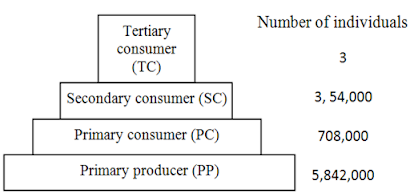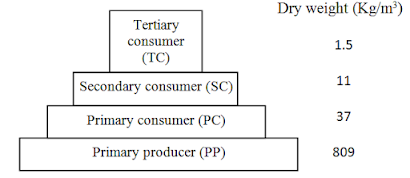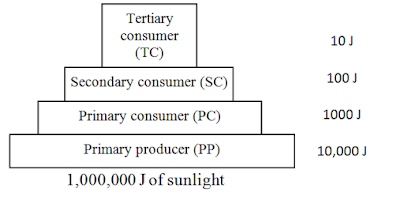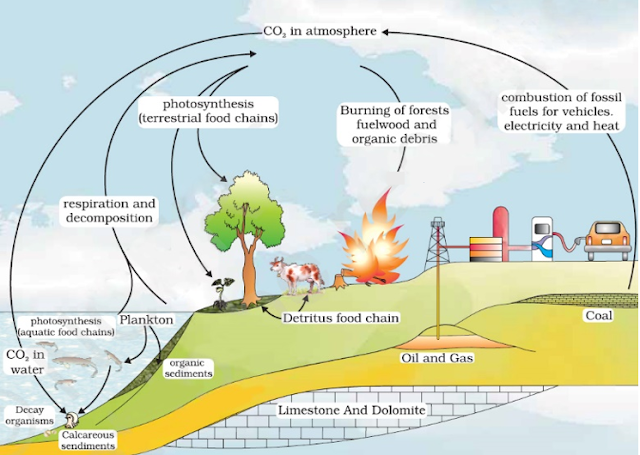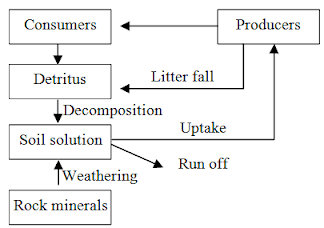Ecosystem : Notes and Study Materials -pdf
14. ECOSYSTEM
ECOSYSTEM – STRUCTURE & FUNCTION
- Terrestrial ecosystem: Forest, grassland, desert etc.
- Aquatic ecosystem: Pond, lake, wetland, river & estuary.
- Man-made ecosystem: Crop fields and aquarium.
A pond is a shallow, simple, self-sustainable water body that exhibits all basic components of an ecosystem.
- Abiotic components: Water and soil deposit.
- Climatic conditions: Solar input, cycle of temperature, day-length etc.
- Autotrophic components: Phytoplankton, some algae and the floating, submerged and marginal plants.
- Consumers (heterotrophs): Zooplankton, free swimming and bottom dwelling forms.
- Decomposers: Fungi, bacteria and flagellates.
- Autotrophs convert inorganic into organic material using solar radiant energy.
- Heterotrophs consume the autotrophs.
- Decomposition and mineralization of the dead matter to release them back for reuse by the autotrophs.
- Productivity
- Decomposition
- Energy flow
- Nutrient cycling
1. PRODUCTIVITY
Amount of biomass (organic matter) produced per unit area over a time period by plants during photosynthesis is called primary production. It is expressed in weight (g–2) or energy (kcal m–2).
The rate of biomass production is called productivity. It is expressed in g–2 yr–1 or (kcal m–2) yr–1.
It is divided into gross primary productivity (GPP) and net primary productivity (NPP).
- Gross primary productivity (GPP): It is the rate of production of organic matter during photosynthesis. A considerable amount of GPP is used by plants in respiration.
- Net primary productivity (NPP): It is the available biomass for the consumption to heterotrophs (herbivores & decomposers). i.e., NPP is the Gross primary productivity minus respiration losses (R).
Secondary productivity: It is the rate of formation of new organic matter by consumers.
Primary productivity varies in different ecosystems because it depends on
- The plant species inhabiting an area.
- Environmental factors.
- Availability of nutrients.
- Photosynthetic capacity of plants.
2. DECOMPOSITION
It is the breakdown of complex organic matter by decomposers into inorganic substances like CO2, water and nutrients.
Raw material for decomposition is called Detritus. E.g. dead plant remains (leaves, bark, flowers etc.), dead remains of animals, fecal matter etc.
- Fragmentation: It is the breakdown of detritus into smaller particles by detritivores (e.g. earthworm).
- Leaching: Water soluble inorganic nutrients go down into soil horizon and precipitate as unavailable salts.
- Catabolism: Degradation of detritus into simpler inorganic substances by bacterial and fungal enzymes.
The above three processes occur simultaneously.
- Humification: Accumulation of humus (dark amorphous substance) in soil. Humus is resistant to microbial action and so decomposes very slowly. Being colloidal, it serves as a reservoir of nutrients.
- Mineralization: It is the release of inorganic nutrients due to the degradation of humus by some microbes.
1. Chemical composition of detritus:
- Decomposition is slow in detritus rich in lignin & chitin.
- It is quicker in detritus rich in nitrogen and water-soluble substances like sugars.
- Warm and moist environment favour decomposition.
- Low temperature & anaerobiosis inhibit decomposition resulting in buildup of organic materials.
3. ENERGY FLOW
Sun is the only source of energy for all ecosystems (except deep sea hydro-thermal ecosystem).
Of the incident solar radiation, less than 50% is photosynthetically active radiation (PAR).
Plants and photosynthetic bacteria (autotrophs), fix solar radiant energy to make food.
Plants capture only 2-10% of the PAR. This energy sustains the entire living world.
Ecosystems obey 2nd Law of thermodynamics. They need a constant supply of energy to synthesize the molecules. It helps to counteract the entropy.
Producers (Autotrophs):
These are organisms that synthesize food.
In a terrestrial ecosystem, major producers are herbaceous and woody plants. Primary producers in an aquatic ecosystem are phytoplankton, algae and higher plants.
The energy trapped by the producer is passed on to a consumer or the organism dies.
Consumers (heterotrophs):
These are animals that directly or indirectly depend on plants for food. They include:
- Primary consumers (herbivores): Feed on plants. E.g. insects, birds, mammals, molluscs etc.
- Secondary consumers (primary carnivores): Feed on herbivores. E.g. frog, fox, man etc.
- Tertiary consumers (secondary carnivores): Feed on primary carnivores. E.g. tiger, lion etc.
The chain of feeding relationship between different organisms is called a food chain. It is 2 types:
- Grazing Food Chain (GFC): Here, primary consumer feeds on living plants (producer). E.g.
- Detritus Food Chain (DFC): Here, primary consumer feeds on dead organic matter (detritus). Death of organism is the beginning of the DFC.
Detritus is made up of decomposers (saprotrophs) such as fungi & bacteria. They secrete digestive enzymes that breakdown detritus into simple, inorganic materials, which are absorbed by them. Thus, they get energy & nutrients.
In an aquatic ecosystem, GFC is the major conduit for energy flow.
In a terrestrial ecosystem, a much amount of energy flows through the DFC than through the GFC.
DFC may be connected with GFC at some levels. Some organisms of DFC are prey to the GFC animals. Some animals (cockroaches, crows, human etc.) are omnivores. Such interconnections of food chains are called food web.
A specific place of organisms in the food chain is known as their trophic level.
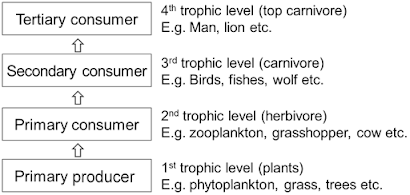
The amount of energy decreases at successive trophic levels. When an organism dies it becomes dead biomass (detritus). It is an energy source for decomposers.
Organisms at each trophic level depend on those at the lower trophic level for their energy.
The amount of living material in a trophic level at a given time is called standing crop. It is measured as the biomass (mass of living organisms) or the number in a unit area.
Biomass of a species is measured in terms of fresh or dry weight. Dry weight is more accurate because it is the exact mass of body which remains constant.
Number of trophic levels in GFC is restricted as it follows 10% law (only 10% of energy is transferred to each trophic level from the lower trophic level).
ECOLOGICAL PYRAMIDS
The representation of a food chain in the form of a pyramid is called ecological pyramid.
The base of a pyramid represents producers (first trophic level). The apex represents tertiary or top-level consumer.
Ecological pyramids are 3 types: Pyramid of number, Pyramid of biomass and Pyramid of energy.
Any calculations of energy content, biomass, or numbers has to include all organisms at that trophic level.
A trophic level represents a functional level, not a species as such. A species may occupy more than one trophic level in the same ecosystem at the same time. E.g. A sparrow is a primary consumer when it eats seeds, fruits, peas. It is a secondary consumer when it eats insects & worms.
In most ecosystems, all the pyramids are upright, i.e., producers are higher in number, biomass and energy than the herbivores, and herbivores are higher in number, biomass and energy than the carnivores.
But in some cases, inverted pyramids for number and biomass are present.
Inverted pyramid of number: E.g. Insects feeding on a tree.
Inverted pyramid of biomass: E.g.
- Small standing crop of phytoplankton supports large standing crop of zooplankton.
- Pyramid of biomass in sea is inverted because the biomass of fishes far exceeds that of phytoplankton.

Pyramid of energy is always upright because some energy is always lost as heat at each trophic level. So energy at a lower trophic level is always more than at a higher level.
- It does not consider the same species belonging to two or more trophic levels.
- It assumes a simple food chain that never exists in nature. It does not accommodate a food web.
- Saprophytes are not included.
ECOLOGICAL SUCCESSION
It is a gradual, slow and predictable change in the species composition of an area leading to a climax community (community that is in equilibrium with the environment).
In this, some species colonize an area and increase in number, whereas other species decline and disappear.
The entire sequences of communities that successively change in an area are called sere. Individual transitional communities are termed seral stages (seral communities).
The species invading a bare area are called pioneer species.
During succession, there is a change in species diversity, increase in number of species and organisms and an increase in total biomass.
Present-day communities are due to succession of millions of years. Succession and evolution were parallel processes.
Succession is 2 types:
- Primary: The succession taking place in areas where no living organisms ever existed. E.g. newly cooled lava, bare rock, newly created pond or reservoir.
To establish a biotic community, fertile soil must be formed. So primary succession is a very slow process.
- Secondary: The succession taking place in an area after the existed organisms are lost. E.g. abandoned farm lands, burned or cut forests, lands that are flooded.
Since some soil or sediment is present, succession is faster than primary succession.The species that invade depend on the nature of the soil, availability of water etc.
In succession, changes in vegetation affect food & shelter of animals. Thus, succession leads to change in number and types of animals & decomposers.
Natural or human induced disturbances (deforestation, fire etc.) convert a particular seral stage to an earlier stage. They create new conditions that encourage some species and discourage or eliminate other species.
Based on the nature of the habitat, succession of plants is 2 types: hydrarch and xerarch.
- Hydrarch succession: It takes place in wetter areas. It progresses from hydric to mesic conditions.
- Xerarch succession: It takes place in dry areas. It progresses from xeric to mesic conditions.
Hence, both hydrarch & xerarch successions lead to medium water conditions (mesic, the climax community).
Primary succession on rocks (xerophytic habitat):
Lichens (pioneer species. They secrete acids to dissolve rock, helping in weathering & soil formation) → small plants like bryophytes (they need only small amount of soil) → bigger plants → forest (mesophytic).
The climax community (forest) remains stable if the environment remains unchanged.
Primary succession in water:
Phytoplankton (pioneers) → rooted-submerged plants → rooted-floating angiosperms → free-floating plants → reed-swamp → marsh-meadow → scrub → trees (climax community is a forest).
With time, the water body is converted into land.
4. NUTRIENT CYCLING
Amount of nutrients (C, N, P, Ca etc.) present in the soil in a given time is called the standing state. It varies in different kinds of ecosystems and also on a seasonal basis.
Nutrients are never lost from the ecosystems. They are recycled again and again.
The movement of nutrient elements through various components of an ecosystem is called nutrient cycling (biogeochemical cycles).
Nutrient cycles are 2 types:
- Gaseous cycle: For this, the reservoir exists in the atmosphere. E.g. Nitrogen & Carbon cycles.
- Sedimentary cycle: For this, the reservoir is located in Earth’s crust. E.g. Sulphur & Phosphorus cycles.
Environmental factors (soil, moisture, pH, temperature, etc.) regulate the rate of release of nutrients into the atmosphere. The reservoir meets with the deficit of nutrients due to imbalance in the rate of influx and efflux.
Reservoir of carbon: Atmosphere (about 1%), organisms (49% of dry weight), oceans (71% dissolved carbon. It regulates the amount of atmospheric CO2), fossil fuel etc.
Carbon cycling occurs through atmosphere, ocean and through living and dead organisms.
4×10^13 kg of carbon is fixed in the biosphere through photosynthesis annually.
A major amount of carbon returns to the atmosphere as CO2 through respiration.
Processing of wastes & dead organic matter by decomposers also release CO2.
Some amount of the fixed carbon is lost to sediments and removed from circulation.
Burning of wood, forest fire and combustion of organic matter, fossil fuel and volcanic activity are other sources for releasing CO2 in the atmosphere.
Role of human activities in carbon cycle: Deforestation, burning of fossil fuel etc. has increased the rate of release of CO2 into the atmosphere.
Phosphorus is a constituent of biological membranes, nucleic acids & cellular energy transfer systems. Many animals use phosphorus to make shells, bones and teeth.
The natural reservoir of phosphorus is rock (in the form of phosphates).
When rocks are weathered, minute amounts of phosphates dissolve in soil solution and are absorbed by the plants. Herbivores and other animals obtain this from plants. The waste products and the dead organisms are decomposed by phosphate-solubilising bacteria releasing phosphorus.
Carbon cycle | Phosphorous cycle |
Atmospheric input is higher | Much smaller |
There is gaseous exchange between organism & environment | Gaseous exchange is negligible |
ECOSYSTEM SERVICES
The products of ecosystem processes are called ecosystem services.
E.g. forest ecosystems purify air and water, mitigate droughts and floods, cycle nutrients, generate fertile soils, provide wildlife habitat, maintain biodiversity, pollinate crops, provide storage site for carbon and provide aesthetic, cultural & spiritual values.
Robert Costanza and his colleagues have tried to put price tags on nature’s life-support services.
Researchers have put an average price tag of US $ 33 trillion a year on fundamental ecosystems services. This is nearly twice the value of the global gross national product GNP (US $ 18 trillion).
Out of this total cost, soil formation accounts for about 50%.
Contributions of other services like recreation & nutrient cycling are less than 10% each.
The cost of climate regulation and habitat for wildlife are about 6 % each.
CBSE Class 12 Biology Important Questions Chapter 14 – Ecosystem
1 Mark Questions
Chapter 14
Ecosystem
1 Marks Questions
1. Decomposition is faster if deteritus is rich in nitrogen and water soluble substance like sugars. When is the decomposition process slower?
Ans.Its slower if detritus is rich in lignin and chitin.
2. If we count the number of insects on a tree and number of small birds depending on those insects as also the number of larger birds eating the smaller, what kind of pyramid of number would we get?
Ans.Inverted Pyramid of Number .
3. Differentiate between Sere and Seral communities.
Ans.Sere :Entire sequence of communities that successively change in a given area.Serial community :Individual transitional community .
4. Who are generally the pioneer species in a Xerarch succession and in a Hyararch succession?
Ans.Pioneer species in Hydrarch succession are usually the small phytoplanktons and that in Xerarch succession are usually lichens.
5. Which metabolic process causes a reduction in the Gross Primary Productivity?
Ans.Respiration.
6. What percentage of photosyntheticallyactive radiation is captured by plants?
Ans.2 – 10%
7. Name the pioners of primary succession in water.
Ans.Phytoplanktons
8.Name any two man – made ecosystem?
Ans.Aquarium & Garden.
9.Define stratification?
Ans.Stratification in an ecosystem refers to the vertical distribution of different species occupying different levels.
10.Name the ecological pyramid that is always upright?
Ans.Pyramid of energy.
11.Name the trophic level occupied by secondary consumers & tertiary consumers?
Ans.Third trophic level & fourth trophic level respectively
12.Define standing crop?
Ans.The amount of living matter or biomass present at every tropic level is known as standing crop.
13.Name the ecological pyramid that is inverted in tree ecosystem?
Ans.Pyramid of Number.
14.What are the products of decomposition?
Ans. CO2, H2O & nutrients.
15.What is 10% law?
Ans.At each trophic level, 90% energy is degraded into heat & only 10% is transferred to next trophic level this rule is called 10% law.
16.Mention one similarity between hydrach&Xerach secession?
Ans.Both hydrach&xerach leads to establishment of similar mesic conditions.
17.What is the approximate value of net primary productivity of biosphere?
Ans.170 billion tons.
18.Name two climatic factors that regulate decomposition?
Ans.Chemical composition of detritus & climatic factors.
19.What is sere?
Ans.The entire sequence of communities that successively change in a given area resulting in climax community is called sere.
20.Name the primary consumers in aquatic ecosystem?
Ans.Zoo planktons.
21.Name the pioneer species in the primary succession on rock?
Ans.Lichens.
2 Mark Questions
Chapter 14
Ecosystem
2 Marks Questions
1. What is the shape of pyramid of biomass in sea? Why?
Ans. Inverted, because biomass of fishes far exceeds that of phytoplankton.
2. Give an example of an ecological pyramid which is always upright. Justify your Answer.
Ans.Pyramid of energy is always upright and can never be inverted, because when energy flows from a trophic level to the next trophic level some energy is always lost as heat at each step.
3. Differentiate between primary succession and secondary succession. Which one occurs faster?
Ans. Primary Succession :Aprocess that starts where no living organisms are there. Secondary succession :Aprocess that starts in areas which have lost all the living organisms that existed there.
4. Gaseous nutrient cycle and sedimentary nutrient cycles have their reservoir . Name them. Why is a reservoir necessary?
Ans.Reservoir for Gaseous nutrient cycle : Atmosphere; for sedimentary nutrient cycle : Earth’s crust. Reservoir is needed to meet with the deficit which occurs due to imbalance in the rate of influx and efflux.
5. Fill up the missing links depicted as A, B, C and D in the given model of primary succession.
Ans. A = Submerged plant stage B = Reed Swamp Stage
C = Scrub stage D = Forest stage
6. In the model of phosphorus cycle given below , what does A, B, C and D refer to?
Ans. A = Detritus B = Decomposition
C = Weathering D = Producers.
7. Differentiate between Hydrarch and a Xerarch succession.
Ans.HydrarchSuccession :Starts in water proceeds from hydric (aquatic) to mesic (neither dry nor wet) situations. Xerarchsuccession :Starts on barren rock Proceeds from Xeric (dry) conditons.
8. What is the effect on decomposition rate if :–
a) Detritus is rich in lignin and chitin
b) Detritus is rich is nitrogen and sugars
Ans. a) Decomposition rate is slower
b) Decomposition rate is faster.
9. What are the limitations of ecological pyramids?
Ans. (i) Does not take into account same species belonging to two or more trophic levels.
(ii) Assumes simple food chain, does not accomodate food web.
(iii) Saprophytes have not been given any place in ecological pyramids.
10. Name any four ecosystem services. Who gave the price tags on nature’s life support services? Which is the most important ecosystem service provider?
Ans.
- Forest (ecosystem) purify water and air
- Mitigate Droughts and floods
- Nutrient cycling
- Generate fertile soil
- Provide habitat for wildlife
- Pollinate flower
- Maintain Biodiversity
- Provide aesthetic, cultural & spiritual values
- Robert Constanza gave price tags to ecosystem services.
- Most important ecosystem services provider : Soil formation.
11. Study the table given below and fill the blanks from ‘A’ to ‘F’.
| S.No | Component of the Ecosystem | Position of the trophic level | Organism present in the Food chain |
| 1. 2. 3. 4. | E Secondary consumer B Primary producer | Fourth trophic level D Second trophic level A | F Bird, fish, wolf. C Phytoplankton, grass, tree. |
Ans.A = First trophic level
B = Primary consumer
C = Zooplankton, Cow, Grass hopper
D = Third trophic level
E = Tertiary consumer
F = Man, Lion
12. In the pyramid of biomass drawn below , name the two crops (i) one which is supported (ii) one which supports in which ecosystem is such a phyramid found?
Ans. (i) Supported trophic level is founded by zooplanktons
(ii) Supporting trophic level is formed by phytoplanktons ecosystem It is found in aquatic ecosystem.
13.Why is secondary sucession faster than primary sucession?
Ans.Secondary succession refers to community development on sites previously occupied by welldeveloped communities where the environment is both organic & inorganic. Since these bare areaspossesses suitable soil for proper growth so, secondary successes is more rapid them primarysuccession.
14.Distinguish between upright & inverted pyramids?
Ans.In upright pyramid the number of producers or its biome is maximum in an ecosystem & it decreases progressively at each trophic level. Whereas in inverted pyramid at producer level is minimum & is increasing progressively at each trophic level in a food chain.
15.Explain with an example, why is the length of a food chain in an ecosystem generally limited to 3-4 tropic level?
Ans.In a food chain at each trophic level about 90% of energy is degraded into heat & only 10% energy is transferred to next tropic level thus of trophic levels in the food chain the amount energy to be transferred to next trophic level will be approximately negligible thus a food chain is generally limited to 3-4 trophic levels.
16.What is meant by ecological succession? Describe the different stages in which succession occurs?
Ans.Ecological succession is a community – controlled phenomenon in which the structure &composition of community changes in an orderly & sequential manner, leading ultimately toestablishment climax community.
STAGES OF SUCESSION :-
i) Invasion :- Invasion is the arrival of propagating organ e.g. seed spores bulbils etc on a bare areaof primary or secondary succession. Those for which conditions are favorable germinate is newarea& some of them grow into mature plants. These new arrivals from outside are called pioneer.
ii) Establishment :- The process by which migrants adjust themselves in new areas after migrationis called ecesis. It consists of three essential processes – germination, growth & reproduction.
iii) Aggregation :- The coming together of individuals of various species in an area are calledaggregation.
iv) Competition :- The species which have similar requirements of nutrition are known ascompetitive species eg. those with different requirement are complimentary species.
v)Reaction :- It is the change brought about by colonizers in the habitat. The influence of vegetation on the site is called reaction till a stable community develops in that area.
17.What is meant by ecological pyramid? With the help of one example each, show that pyramid of number can be both upright as well as inverted.
Ans.The graphic representation of the trophic structure of a food chain is known as ecologicalpyramid. The ecological pyramid of number represents the numerical representation betweendifferent trophic both upright or inverted.
In upright pyramid of numbers, the more abundant species form the first trophic level & forms thebase of pyramid & less abundant species remains near the top e.g. Grass land ecosystem.
Green plants →→ Rabbit →→fox→→Lion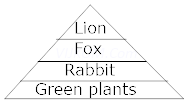
In inverted pyramid of number, the most abundant species occurs at the top while the less abundantspecies forms the base eg. Tree ecosystem
Tree →→Birds →→Parasite
18.Describe the components of an ecosystem?
Ans.Ecosystem is a functional unit of nature consisting of biotic & abiotic factors where the livingorganisms interact among themselves & with physical environment. Ecosystem consists of twocomponents:-
i) ABIOTIC COMPONENTS :- e.g.
a) Inorganic substances phosphorus, sulphur, carbon, nitrogen hydrogen tec.
b) Organic substances e.g. carbohydrates, proteins, lipids.
c) Climatic regime e.g. light, humidity, rainfall, temperature.
ii) BIOTIC COMPONENTS:
a) Producers :- The organisms which produce food for themselves & for all living organism frominorganic raw material with the solar radiation are called producers.
b) Consumers :- Those living heterotrophic members of ecosystem which consume the foodsynthesized lay producers. They are broadly classified as.
i) Primary consumers:- They are directly dependent on producers called herbivores e.g. rat, deer,cow, goat,.
ii)Secondary consumers:- The organism that use primary consumers as their food are calledcarnivores e.g. fox cats, lions.
iii)Tertiary consumers:- These are top carnivores which prey upon other carnivores, & herbivores
e.g. crow, man.
c)Decomposers :- Organism that break up the dead bodies of plants animals & the related wasteproducts are called decomposers e.g. bacteria, Fungi etc.
19.“Energy flow in an ecosystem is always unidirectional justify the statement.
Ans.Energy flow in an ecosystem is always unidirectional meAns that energy is always trAnsferredfrom one trophic level to next trophic level & is not reverted back – e.g. energy from sun is capturedby producers which are then eaten by primary consumer & energy is trAnsferred to next tropic level.
20.Differentiate between Production & decomposition?
Ans.Production refers to the process of synthesis of organic food materials from inorganicsubstances such as CO2 H2O in the presence of sunlight whereas decomposition is a process ofbreakdown of complex substances into its constituents & it is brought about by bacteria, fungi etc.
21.Explain who pyramid of energy of an ecosystem is always uprights never inverted?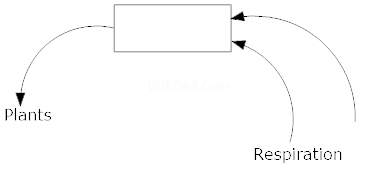
Ans. The pyramid of energy represents total amount of energy utilized by different trophic levelorganism in unit area. At each level, total energy available is relatively more than at higher trophiclevel because of loss of energy from one trophic level to other thus, pyramid of energy is always straight.
22. i) Name the compound whose cycle is depicted.
ii) In what way do vehicles add this compound to atmosphere?
iii) What adverse effect does its excess have on the environment?
iv) Cite an event which depicts this effect in modern times.
v) Suggest two ways of depleting this effect.
Ans. i) Carbon cycle
ii) By burning of fossil fuel e.g. diesel or petroleum, they introduce CO2 in the atmosphere
iii) Environmental pollution.
iv) Ozone layer depletion
v) a) By reducing use of fossil fuels
b) By planting more & more trees.
23.What do you mean by “productivity of an ecosystem? What are the types of productivity also mention the factors on which productivity of an ecosystem depends?
Ans.Productivity of an ecosystem is the rate at which solar radiations energy is fixed by vegetationof an ecosystem per unit area & per unit time. It is general expressed in terms of unit of energy (cal)produced in a unit area (m2) per unit time (year).
Productivity can be of two types:-
1) Primary Productivity:- It is defined as the amount of biomass or organic matter produced per unit area over a time period by plants during photosynthesis primary productivity can further be of two types:-
a) Gross primary productivity :- It refers to the total amount of food formed lay producers.
b) Net primary productivity:- It refers to gross production minus loss lay respiration & decomposition NPP = GPP – respiration loss
2) Secondary Productivity :- The rate of storage at consumer level is secondary productivity. It isthe rate of resynthesis of organic food by consumers primary productivity depends on:-
i) a number of environmental factors
ii) availability of nutrients.
iii) photosynthetic capacity of plants.
24.What is decomposition – Describe thedifferent processes involved in decomposition?
Ans.Decomposers e.g. bacteria, fungietc. helps in breakdown of complex organic matter intoinorganic substances like CO2, water minerals & this process is called decomposition. Dead plantremains e.g. leaves, bark flowers & dead remain of animals including faecal matter constitutedetritus. The important processes involved in decomposition or :-
i) Fragmentation :-Detritivores breaks down detritus into smaller particles.
ii) Leaching :- Water soluble inorganic nutrients go down into soil horizon & get precipitated asunavailable salts lay process of leaching.
iii) Catabolism:- The enzymes of bacteria & fungi degrade detritus into simple inorganicsubstances
iv) Humification :-Humification leads to accumulation of a dark colored amorphous substancecalled humus that is highly resistant to microbial action & undergoes decomposition at extremelyslower rate.
v) Mineralisation :- The humus is further degraded by some microbes & release of inorganicnutrients occurs by the process of mineralization.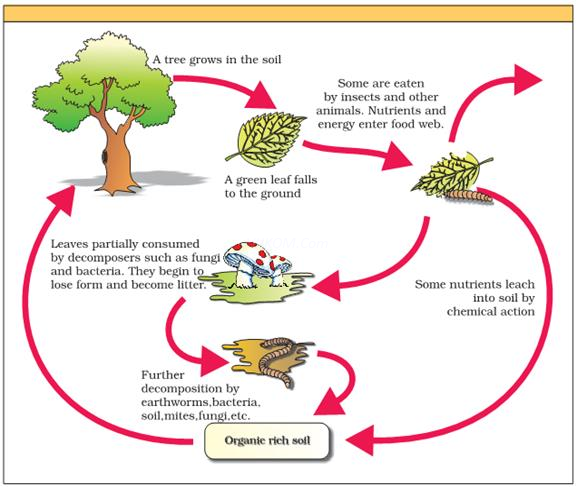
25.Why is productivity of coral reef maximum?
Ans.The productivity of coral reef is maximum because of availability of good light, enough warm water and abundant nutrients.
26.In the pyramid of biomass, drawn below, name the two crops:-
i) one which is supported & the one which supports
ii) In which ecosystem is such a pyramid found.
Ans. i) In this ecosystems bird is supported & insect supports.
ii) Such type of pyramid is found in ecosystem of pond or tree.
27.Differentiate between primary productivity & secondary productivity?
Ans.Primary productivity refers to productivity at trophic level i.e. food energy formed by way of photosynthesis using solar energy whereas secondary productivity refers to gross productivity minus losses by way of respiration & decomposition.
28.What ecological principles are derived from the study of food chains?
Ans. i) Each food chain is complete & self – containing
ii) All the food chains must always begin with photosynthesis & ends with decay
iii) Shorter food chains are more efficient because the more steps it has, greater the wastage ofenergy.
iv) The successive members of food chains are large in size but fewer in number.
29.List the factors on which pioneer species depend during secondary succession?
Ans.In secondary succession, the type of pioneer species depends on :-
i) Conditions of the soil
ii) Availability of water
iii) Environmental conditions
iv) Seeds or other propagules present.
30.The productivity of ecosystem increases from polar regions towards tropics. Why?
Ans. The productivity of ecosystem increases from polar region towards tropics because of the increasing sunlight & temperature.
31.Mention some of the ecological services provided by forests?
Ans.i) Forests purify air
ii) They mitigate droughts & floods.
iii) They help in cycling of nutrients.
iv) They provide habitat to number of wild life
v) They maintain biodiversity.
32.Differentiate between food chain & food web?
Ans.The unidirectional sequence of organisms in which energy flows in the form of food from oneorganism to another through the process of eating & being eaten is called food chain whereas thenetwork of interlinked food chains are collectively known as food web.
3 Mark Questions
Chapter 14
Ecosystem
3 Marks Questions
1. With the help of a diagram, represent the energy flow through different trophic level.
Ans.In an ecosystem, energy flows through different trophic level by food chain. In consists of two steps:-
i) Trapping solar energy:- Primary source of energy is sun only 48% of sun’s energy reaches the surfaceof earth & only a part of it is used lay plants for photosynthesis. The chemical energy produced lay plantsis stored in plant tissues. The photosynthetic organism uses a part of this chemical energy & transfer therest to organism at next trophic level.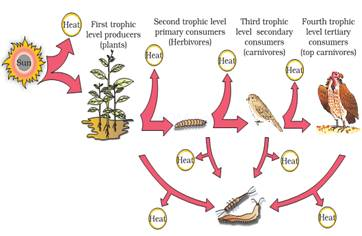
ii) Path & flow of energy:- The primary consumers therefore take chemical potential energy in the form offood. Most of it dissipates as heat during respiration & is lost out of ecosystem. The same process isrepeated at secondary consumers, at each trophic level 90% energy is degraded into heat& only 10% is thentransferred to next trophic level this rule of energy flow is alled ten percent law.
2. What is pyramid of biomass? Represent the pyramid of biomass in
(i) grassland ecosystem
(ii)aquatic ecosystem.
Ans.The biomass means the total weight of fry matter pyramid of biomass represents the weight of drymatter at different trophic levels of ecosystem at one time in a food chain of food web.
i) Grassland ecosystem :- In grassland ecosystem, the pyramid of biomass is upright i.e. pyramid ofbiomass shows gradual reduction in biomass at each trophic level from base to apex.
Grass →→cow→→fox →→Lion
ii) In pond aquatic ecosystem, the biomass of consumers is always greater than biomass of producers hence itoccurs as an inverted pyramid
5 Marks Questions
Chapter 14
Ecosystem
5 Marks Questions
1.Represent schematically & describe the phosphorus cycle in an ecosystem?
Ans. The major reservoir of phosphorus is sedimentary rocks which are only available to basic cycle insmall amounts as a result of weathering. These phosphorus are weathered & later transported to thesoil by wind & water, where they exist as inorganic dissolved phosphates.
The basic phosphorus cycle begins with dissolved phosphates which are absorbed by plants for makingtheir own tissue plants are eaten by animals. Decay bacteria breakdown the tissue of dead animalsdown these product & return phosphate to soil.
The water – soluble phosphates is lost to the deep rudiments of the ocean through run-off. The major pathway of returning phosphorus to land is uplifting of marine sediments. Some amount of phosphorus is returned to absorb inorganic phosphate, when they die, most of absorbed phosphate is recycled back into ambient mater. This sort of cycling is called biological cycle or metabolic cycle.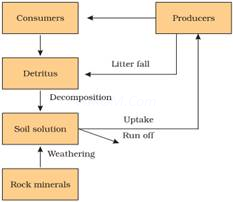
2.Represent schematically & describe carbon cycle in ecosystem?
Ans.The source of carbon is atmosphere & water. Carbon is present in atmosphere mainly in the form of CO2CO2. It is vital to the production of carbohydrates through photosynthesis.
6CO2+ 12 H2O6CO2+ 12 H2O −→−−−−−chlorophyllh2 C6H12O6 + 6H2O + 6O2↑→chlorophyllh2 C6H12O6 + 6H2O + 6O2↑
In atmosphere, carbon is present in the form of CO2CO2 from the atmosphere it is incorporated into tissuesof green plants e.g. carbohydrates, proteins & lipids.
The CO2CO2 dissolved in sea water is utilized lay marine animals like protozoans, corals, mollusks etc fortheir life. In these animals, CO2CO2 is converted into calcium carbonate which is used for construction ofshell.
Co2+H2O→H2CO3→HCO3→CaCO3+H+Co2+H2O→H2CO3→HCO3→CaCO3+H+
After death of marine animals, CaCO3 store in shells is either deposited as sedimentary rock or dissolvedin water to release CO2CO2. A certain proportion of carbon is deposited as coal carbon from coal returns toair in the form of CO2CO2 through combustion & weathering thus, carbon from atmospheric pool moves togreen plants, then to animals & finally to bacteria fungi etc. to return it to atmosphere throughdecomposition-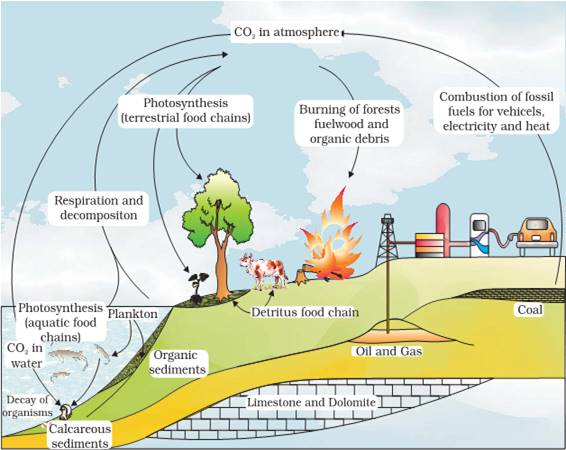
Ecosystem Class 12 Biology MCQs
1. Which of the following represents the sedimentary type of nutrient cycle?
(a) Nitrogen cycle
(b) Carbon cycle
(c) Phosphorus cycle.
(d) Oxygen cycle
Answer
Answer: c
2. In a pond ecosystem, the food chain starts with
(a) Zooplanktons.
(b) Small insects
(c) Phytoplanktons
(d) Small fishes
Answer
Answer: c
3. The last stable community in succession that is in equilibrium with the environment, is called
(a) serai community
(b) pioneer community
(c) climax community
(d) all of these
Answer
Answer: c
4. Which of the following is a pioneer species in xerarch succession?
(a) Phytoplanktons
(b) Lichens
(c) Bryophytes
(d) Sedges
Answer
Answer: b
5. Which of the following statements is correct for secondary succession?
(a) It begins on a bare rock.
(b) It occurs on a deforested area.
(c) It follows primary succession.
(d) It is similar to primary succession, but has a relatively fast pace.
Answer
Answer: d
6. The sequence of communities of primary succession in water is [NCERT Exemplar]
(a) phytoplankton, sedges, free-floating hydrophytes, rooted hydrophytes, grasses and trees.
(b) phytoplankton, free-floating hydrophytes, rooted hydrophytes, sedges, grasses and trees.
(c) free-floating hydrophytes, sedges, phytoplankton, rooted hydrophytes, grasses and trees.
(d) phytoplankton, rooted submerged hydrophytes, floating hydrophytes, reed swamp, sedges, meadow and trees.
Answer
Answer: d
7. The reservoir for the gaseous type of biogeochemical cycle exists in [NCERT Exemplar]
(a) stratosphere
(b) atmosphere
(c) ionosphere
(d) lithosphere
Answer
Answer: b
8. The process of mineralisation by micro organisms helps in the release of [NCERT Exemplar]
(a) inorganic nutrients from humus
(b) both organic and inorganic nutrients from detritus
(c) organic nutrients from humus
(d) inorganic nutrients from detritus and formation of humus.
Answer
Answer: a
9. Which of the following ecosystems is most productive in terms of net primary production? [NCERT Exemplar]
(a) Deserts
(b) Tropical rain forests
(c) Oceans
(d) Estuaries
Answer
Answer: b
10. Approximately how much of the solar energy that falls on the leaves of a plant is converted to chemical energy by photosynthesis? [NCERT Exemplar]
(a) Less than 1%
(b) 2-10%
(c) 30%
(d) 50%
Answer
Answer: b
11. Vertical distributioon of different species occupying different levels in an ecosystem, is called _______ .
Answer/Explanation
Answer:
Explaination: Stratification.
12. The rate of production of biomass is termed as _______ .
Answer/Explanation
Answer:
Explaination: Productivity.
13. The degradation of humus by some microbes to release the inorganic nutrients, is called _______ .
Answer/Explanation
Answer:
Explaination: Mineralisation.
14. _______ of organisms is the beginning of the detritus food chain.
Answer/Explanation
Answer:
Explaination: Death.
15. _______ are the saprotrophs (heterotrophs) which meet their energy requirements by degrading the detritus.
Answer/Explanation
Answer:
Explaination: Decomposers.
16. The amount of energy _______ at successive trophic levels.
Answer/Explanation
Answer:
Explaination: Decreases.
17. The _______ is measured as biomass or number per unit area.
Answer/Explanation
Answer:
Explaination: Standing crop.
18. The pyramid of number in a grassland ecosystem is .
Answer/Explanation
Answer:
Explaination: Upright.
19. are the pioneer species in the primary succession on a rock.
Answer/Explanation
Answer:
Explaination: Lichens.
20. The technical term given to nutrient cycles is cycles.
Answer/Explanation
Answer:
Explaination: Biogeochemical.
21. Match the items in Column I with those in Column II.
| Column I | Column II |
| A. Standing crop | 1. The amount of mineral nutrients in the soil at a given time |
| B. Standing state | 2. Sedementary cycle |
| C. Climax community | 3. Herbivores and carnivores |
| D. Primary producers | 4. In near equilibrium with the environment |
| E. Phosphorus cycle | 5. Mass of living matter in a trophic level at a given time |
| F. Secondary producers | 6. Phytoplanktons |
Answer/Explanation
Answer:
Explaination: A – 5, B – 1, C – 4, D – 6, E – 2, F – 3
22. Match the items in Column I with those in Column II.
| Column I | Column II |
| A. Pyramid of energy | 1. Phytoplanktons |
| B. Pyramid of biomass | 2. Mesic forest |
| C. Climax community | 3. Upright/inverted |
| D. Hydrarch succession | 4. Always upright |
| 5. Pioneer species |
Answer/Explanation
Answer:
Explaination: A – 4, B – 3, C – 2, D – 1
23. Natural or man-made distribances during succession, can convert a particular serai stage to an earlier stage. [True/False]
Answer/Explanation
Answer:
Explaination: True.
24. The pioneer species always remain in equilibrium with the environment and do not change easily. [True/False]
Answer/Explanation
Answer:
Explaination: False.
25. The function of reservoir of any nutrient cycle is to store as much matter as possible. [True/False]
Answer/Explanation
Answer:
Explaination: False.
26. In a hydrarch succession, the marsh-meadow stage is preceded by the scrub stage. [True/False]
Answer/Explanation
Answer:
Explaination: False.
27. In an ecological pyramid, the amount of energy available at the lower trophic level is always more than that at a higher trophic level. [True/False]
Answer/Explanation
Answer:
Explaination: True.
Directions (Q28 and Q29): Mark the odd one in each of the following groups.
28. Phytoplanktons, Zooplanktons, Reed-swamp stage, Lichens.
Answer/Explanation
Answer:
Explaination: Lichens.
29. Fragmentation, Stratification, Leaching, Catabolism.
Answer/Explanation
Answer:
Explaination: Stratification.
30. What is an ecosystem?
Answer/Explanation
Answer:
Explaination: An ecosystem is a functional unit of nature, where biotic components (living organisms) interact among themselves and also with the abiotic environmental or physical factors.
31. What is meant by species composition in an ecosystem?
Answer/Explanation
Answer:
Explaination: Species composition refers to all the plant, animal and microbial species present in a given ecosystem.
32. What is ‘stratification’ in an ecosystem?
Answer/Explanation
Answer:
Explaination: ‘Stratification’ in an ecosystem refers to the vertical distribution of different species occupying different levels.
33. How is ‘ stratification’ represented in a forest ecosystem? [Delhi 2014]
Answer/Explanation
Answer:
Explaination: In a forest, the trees occupy the upper/ topmost vertical strata, the shrubs, the second and herbs, the bottom layers.
34. How is primary productivity in an ecosystem determined? [AI2012C]
Answer/Explanation
Answer:
Explaination: Primary productivity is determined as the amount of biomass or organic matter produced per unit area over a time period by the plants during photosynthesis.
35. GPP – R = NPP
What does ‘R’ represent in the given equation for productivity in an ecosystem? [Delhi 2014C]
Answer/Explanation
Answer:
Explaination: R represents the respiratory losses.
36. What is net primary productivity of an ecosystem? [Foreign 2015]
Answer/Explanation
Answer:
Explaination: Net primary productivity of an ecosystem refers to the biomass available in the producers for consumption by heterotrophs, i.e., herbivores and decomposers.
37. Write the equation that helps in deriving the net primary productivity of an ecosystem. [Delhi 2013]
Or
How is the net primary productivity of an ecosystem derived? [AI 2012C]
Answer/Explanation
Answer:
Explaination: Gross primary productivity (GPP) – Respiratory loss (R) = Net primary productivity (NPP); it is the amount of energy/biomass available in the producers for consumption by herbivores.
38. How is net primary productivity different from gross primary productivity?[AI2012C]
Or
Write a difference between net primary productivity and gross productivity. [AI 2011]
Answer/Explanation
Answer:
Explaination:
Net primary productivity refers to the , biomass/organic matter available at the 1 producer level to the primary consumers,
i.e. GPP – Respiratory losses.
Gross primary productivity is the rate of production of biomass/organic matter by producers during photosynthesis.
39. What is the approximate value of net primary productivity of the biosphere?
Answer/Explanation
Answer:
Explaination: 170 billion tons of (dry weight) organic matter.
40. How much of productivity is contributed by oceans?
Answer/Explanation
Answer:
Explaination: Oceans contribute about 55 billion tons organic matter.
41. Why is the assimilation of energy at the herbivore level, called secondary productivity?
Answer/Explanation
Answer:
Explaination: Herbivores are the primary consumers; the rate of assimilation or formation of new biomass at the consumer level is secondary productivity.
42. All the primary productivity is not available to a herbivore. Give one reason. [HOTS]
Answer/Explanation
Answer:
Explaination: A considerable amount of gross primary productivity is used by the plants in respiration; so not all primary productivity is available for consumers.
43. Name the two climatic factors that regulate decomposition.
Answer/Explanation
Answer:
Explaination: Temperature and soil moisture are the two climatic factors that regulate decomposition.
44. Why is an earthworm called a detritivore? [Foreign 2012]
Answer/Explanation
Answer:
Explaination: Earthworms ingest and breakdown the detritus into smaller particles; hence they are called detritivores.
45. What is meant by PAR?
Answer/Explanation
Answer:
Explaination: The part of the solar radiation which can be absorbed and used by the plants for photosynthesis, is called photosynthetically active radiation (PAR).
46. What are primary carnivores?
Answer/Explanation
Answer:
Explaination: Primary carnivores are the secondary consumers, which depend on the herbivores (primary consumers) for their food needs.
47. What is a detritus food chain made up of? How do they meet their energy and nutritional requirements? [AI 2013]
Answer/Explanation
Answer:
Explaination:
– It is made up of decomposers, i.e. some bacteria and some fungi.
– They meet their energy and nutrient requirements by degrading the dead organic matter or detritus.
48. Name two omnivores that occupy positions in both grazing food chain as well as detritus food chain.
Answer/Explanation
Answer:
Explaination: Cockroaches and crows.
49. Write the basis on which an organism occupies a space in its community/natural surroundings. [Foreign 2010]
Answer/Explanation
Answer:
Explaination: Their feeding relationship with other organisms.
50. Mr Galgotia eats curd/yoghurt. In this case, which trophic level will he occupy? [CBSE Sample Paper 2010; HOTS]
Answer/Explanation
Answer:
Explaination: He occupies third tropic level, i.e., he is a secondary consumer.
51. ‘Man can be primary as well as a secondary consumer.’ Justify this statement. [Foreign 2015]
Answer/Explanation
Answer:
Explaination:
– When man eats plant food, he is primary consumer.
– When he eats meat (animal food), he is a secondary consumer.
52. State what ‘standing crop’ of a trophic level represents. [AI 2013]
Answer/Explanation
Answer:
Explaination: Standing crop of a trophic level represents the amount of living matter (biomass) present at a trophic level at a given time.
53. List any two ways of measuring the standing crop of a trophic level. [Foreign 2010]
Answer/Explanation
Answer:
Explaination:
Standing crop is measured as
(i) biomass, i.e. mass of living organisms in an unit area
(ii) number of organisms in an unit area.
54. How are biomass and standing crop related to each other? [CBSE Sample Paper 2013, 2014]
Answer/Explanation
Answer:
Explaination:
– Biomass is the mass of living organisms or organic matter.
– Standing crop is measured in terms of biomass.
55. Why is measurement of biomass in terms of dry weight more accurate than fresh weight? [HOTS]
Answer/Explanation
Answer:
Explaination: Measurement of biomass in terms of dry weight is more accurate because it avoids variations in weights due to seasonal moisture differences.
56. Define ecological succession.
Answer/Explanation
Answer:
Explaination: Ecological succession is a community controlled phenomenon, in which the structure and composition of communities change in an orderly and sequential manner, leading ultimately to the establishment of a climax community.
57. What is a sere?
Answer/Explanation
Answer:
Explaination: The entire sequence of communities, that successively change in a given area resulting in a climax community, is called a sere.
58. Define climax community.
Answer/Explanation
Answer:
Explaination: The community established at the terminal stage of succession, is called climax community.
59. Mention the role of pioneer species in primary succession on rocks. [Foreign 2012]
Answer/Explanation
Answer:
Explaination: Lichens are the pioneer species in the succession on rocks; they secrete acids to dissolve the rock and help in weathering and soil formation and pave way to bryophytes.
60. In the North East region of India, during the process of jhum cultivation, forests are cleared by burning and left for regrowth after a year of cultivation. How would you explain the regrowth of forest in ecological terms? [HOTS]
Answer/Explanation
Answer:
Explaination: It is secondary succession.
61. Differentiate between standing state and standing crop in an ecosystem. [Foreign 2010]
Answer/Explanation
Answer:
Explaination:
Differences:
| Standing State | Standing Crop |
| – Standing state refers to the amount of nutrients such as nitrogen, phosphorus, calcium, etc. present in the soil of an ecosystem at a given time. | – Standing crop refers to the amount of biomass or organic matter available at a given trophic level/ecosystem at a given time. |
| – It is in the abiotic components. | – It is in the biotic components. |
62. Name the two forms of reservoir of carbon, that regulate the ecosystem carbon cycle.
Answer/Explanation
Answer:
Explaination:
(i) Dissolved carbon in oceans.
(ii) Carbon in fossil fuels.
63. How much of carbon is
(a) fixed in the biosphere through photosynthesis annually?
(b) dissolved in the ocean?
Answer/Explanation
Answer:
Explaination:
(a) 4 × 1013 kg of carbon is fixed annually.
(b) 71% of carbon is dissolved in the ocean.
64. Name the natural reservoir of phosphorus and the form in which it is present.
Answer/Explanation
Answer:
Explaination:
– Rocks are the natural reservoir of phosphorus.
– It is present in the form of phosphates.
65. Who put a price tag for the ecosystem services? What is its value?
Answer/Explanation
Answer:
Explaination:
– Robert Constanza et al have tried to put a price tag. , – It’s estimated to be about 33 trillion US dollars.

